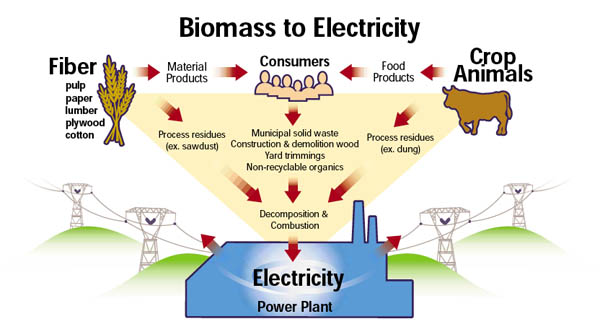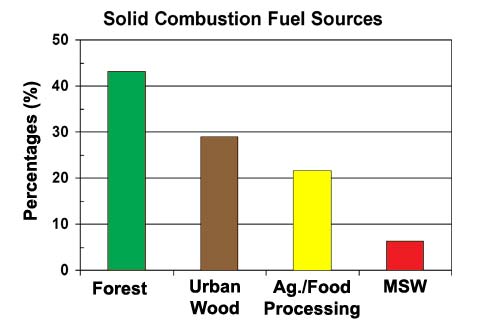Californians create nearly than 2,900 pounds of household garbage and industrial waste each and every second; a total of 85.2 million tons of waste in 2005 (according to the California Integrated Waste Management Board)! Of that, 43.2 million tons is recovered and recycled or used to make energy, but 42 million tons has to be disposed in landfills. Thanks to advances in technology, waste known as biomass, is put to valuable use producing electricity.
In 2007, 6,236 gigawatt hours of electricity in homes and businesses was produced from biomass: burning forestry, agricultural, and urban biomass; converting methane-rich landfill gas to energy (LFGTE); and processing wastewater and dairy biogas into useful energy. Biomass power plants produced 2.1 percent of the total electricity in California in 2007, or about one-fifth of all the renewable energy.
What is biomass electricity?
Biomass electricity is drawn from combusting or decomposing organic matter.
There are about 132 waste-to-energy plants in California, with a total capacity of almost 1,000 megawatts. These plants power our homes and businesses with electricity from waste matter that would have been released into the atmosphere, added fuel to forest fires, and burdened our landfills.

Technology/Fuel Source Number of Facilities Gross Capacity (MW)
Solid Fuel Combustion (includes 3 MSW facilities)
See source percentages below. 30 640
Landfill gas-to-energy 60 275
Wastewater treatment * 20 64
Animal and food waste digester 22 5.7
Totals 132 985
Source: Williams, 2007 (from staff presentation)
* Information incomplete, numbers are probably higher.

Why is biomass electricity important?
Using biomass to produce electricity reduces our reliance on fossil fuels, the nation’s primary energy sources for electricity, and the largest contributors to air pollution and greenhouse gases.
We will eventually run out of fossil fuels.
Biomass electricity offers alternatives with many benefits:
- Our supply of biomass is renewable, meaning it will not run out.
- Electricity produced by biomass reduces the threat of global climate change.
- Using biomass waste eliminates the need to place it in landfills.
- Clearing biomass from wooded areas helps prevent forest fires.
- Using by-product methane gases to produce electricity eliminates odor and reduces air pollution in surrounding areas.
State Policy on Biomass and Biofuels
The Governor directed several state agencies — including the Energy Commission — to take major steps toward the widespread use of biomass to produce clean, renewable transportation fuels or electricity.
This directive helped to reinvigorate the Bioenergy Interagency Working Group through the help of the California Biomass Collaborative.
The Bioenergy Interagency Working Group — lead by Commissioner Jim Boyd of the California Energy Commission, and includes the Air Resources Board (ARB), California Environmental Protection Agency (CalEPA), California Public Utilities Commission, California Resources Agency, Department of Food and Agriculture, Department of Forestry and Fire Protection, Department of General Services, Integrated Waste Management Board, and the State Water Resources Control Board — мейд a recommendation to the Governor in March 2006 on biomass and biofuels.
That report, Recommendations for a Bioenergy Action Plan for California , can be downloaded from our website. (PDF file, 56 pages, 4.5 MB).
The Governor issued an Executive Order S-06-06 (PDF file), signed on April 25, 2006, dealing with biomass and biofuels. Two important points stated that:
- By 2010, 20 percent of its biofuels need to be produced within California; increasing to 40 percent by 2020 and 75 percent by 2050.
- By 2010, 20 percent of the renewable electricity should be generated from biomass resources within the state; maintaining this level through 2020.
The Governor then in July 2006, released California’s Bioenergy Action Plan (PDf file, 11 pages, 2.1 MB). The plan’s objectives included:
- Establish California as a market leader in technology innovation, sustainable biomass development, and market development for bio-based products.
- Coordinate research, development, demonstration, and commercialization efforts across federal and state agencies. —-Develop biomass roadmap.
- Align existing regulatory requirements to encourage production and use of California’s biomass resources.
- Facilitate market entry for new applications of bioenergy including electricity, biogas, and biofuels.
- Maximize the contributions of bioenergy toward achieving the state’s petroleum reduction, climate change, renewable energy, and environmental goals.
Type of Biomass Electricity Production
For a more complete explanation of each type, please visit each page:
- Biomass
- Digester Gas (Anaerobic Digestion)
- Landfill Gas
- Municipal Solid Waste (MSW)
For more information please contact:
Prab Sethi
Energy Research and Development Division
California Energy Commission
Phone: 916-327-1302
E-mail: PSethi@energy.ca.gov
Members of the news media,
please contact the Media and Public Communications Office at 916-654-4989.

 Опубликовано в рубрике
Опубликовано в рубрике  Теги:
Теги: 